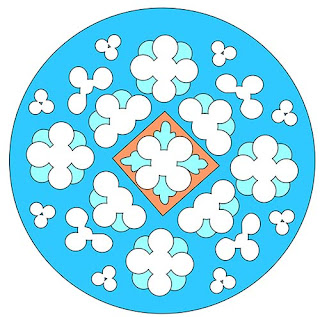Art Brut is a term coined by French painter Jean Dubuffet (1901-1985) - in English, it's called Outsider Art. Here's how the museum explains it:
"Art Brut is made by self-taught people who often live on the margins of society....Among them are prisoners, residents from psychiatric hospitals, eccentrics, loners and outcasts whose creative expression exists for itself, without any concern for public criticism or what other people might think."Three things struck me after an hour in this museum.
- The incredible "wall power" - these pieces grab you.
- The multiple horrific tragedies many of these artists endured. Abandonment, loss, profound mental and physical challenges (including, in some cases, blindness) - and not just one tragedy, but many. Several went silent for decades. I was also surprised at how many of the artists were Jewish, and grappling with the Holocaust (among other issues.)
- Neatness doesn't count.
And this, by Brazilian artist Antonio Roseno de Lima.
And a massive floor-to-ceiling piece by August Walla)
That's just for starters - the museum has 60,000 pieces, 700 of which are on display, so I won't try to show everything I photographed. Below are a few photos of pieces that might be especially interesting to quilters and other fiber artists. Starting with jackets by Dunya Hirschter (1954-2008) from Croatia:
And her accessories: Next, dolls made by Michel Nedjar, (b. 1947), a French Jewish artist obsessed with the Holocaust, fetish dolls, and much more, here.
Also by Nejdar:
Judith Scott, (1943-2005) from Cincinnati, was born with Downs syndrome, deaf and mute, and sent to an institution at 7. She wasn't freed until her twin sister gained custody of her in 1986, when Judith spontaneously took up creative work.
"She would hide all sorts of disparate objects - a fan, an umbrella, magazines - to form the heart of each creation. Having assembled such objects, she would wrap them with yarn, string and various fibers as to protect and conceal them completely."
Similarly, Angus McPhee (1916-1997), from Scotland, went as a young man to serve in WWII, became schizophrenic, was sent to an institution where he went silent for 50 years. Returned home in 1996, he started speaking again, and worked in the fields plaiting grasses like his father did to thatch roofs.
"Angus McPhee hijacked his traditional practice to make various objects and items of clothing: hats, coats, trousers, boots, gloves and shoulder bags among others. He would hang his finished creations from the branches of a tree, hide them in the bushes, or lay them on the ground in a corner of the hospital grounds which served him as an open-air workshop."Here's one of his handbags (which reminded me of handbags I've crocheted from eyelash yarn.)
(By the way, a day later, in a fancy Geneva airport boutique, I saw this pricey designer fur tote bag, in the background, and snap purse, in the front:
On an upper floor, there were display cases full of recent mail art - pieces mailed to the museum curator over the past 20 years. These were obviously made by lots of different people, and I am guessing these were part of a challenge (but I couldn't find an explanatory label).
And finally, on the very top floor is a tiny room packed with the hallucinogenic work of Paul Amar (1919-2017), born in Algiers, who made massive, dense dioramas from shells.
Born to French Sephardic Jewish and Roman Catholic parents, Amar was a soldier in WWII. At age 55 he discovered objects made from shells in a souvenir shop; that became his life's work. He literally ate shellfish frequently to keep up his stock.
"He grinds down and carves mussels, winkles and coral and decorates them...assembles them with glue, then covers them with acrylic paint or nail varnish. Finally he attaches them to lengths of wire...in box-type frames. The pictures are presented in the form of high and low reliefs an are illuminated from within by light bulbs that the artist conceals in sea urchin shells. Ornamentation with vivid pearly colors saturates the scenes and makes them verge on the sacred."Detail of a tree:
If you don't have any plans for a trip to Switzerland, you can explore the collection here. We also loved the Mudoc museum, by the way (it has an incredible show on now about guns and design which I blog about in my next post.)
P.S. I was just told about ANOTHER outsider art museum in Switzerland. I found its website here. Warning: Adult images in the home page scroll.







































































